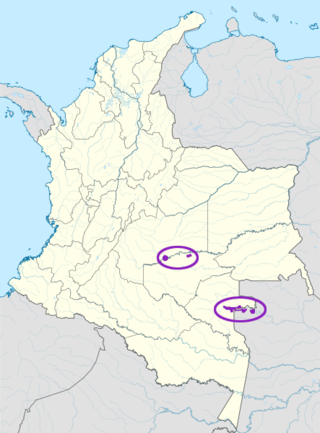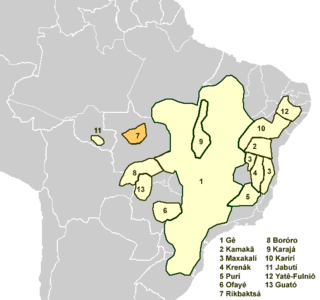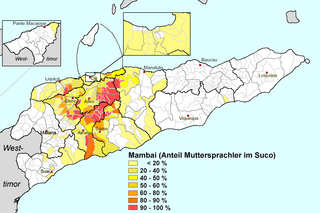The Monguor language is a Mongolic language of its Shirongolic branch and is part of the Gansu–Qinghai sprachbund. There are several dialects, mostly spoken by the Monguor people. A writing system was devised for Huzhu Monguor (Mongghul) in the late 20th century but has been little used.

Tucano, also Tukano or Tucana, endonym Dahseyé (Dasea), is a Tucanoan language spoken in Amazonas, Brazil and Colombia.
Kuman is a language of Chimbu Province, Papua New Guinea. In 1994, it was estimated that 80,000 people spoke Kuman, 10,000 of them monolinguals; in the 2000 census, 115,000 were reported, with few monolinguals. Ethnologue also reported 70,000 second language speakers in 2021.
Chiripá Guarani, also known as Ava Guarani and Nhandéva (Ñandeva), is a Guaraní language spoken in Paraguay, Brazil, and also Argentina. Nhandéva is closely connected to Mbyá Guaraní, as intermarriage between speakers of the two languages is common. Speakers of Nhandéva and Mbyá generally live in mountainous areas of the Atlantic Forest, from eastern Paraguay through Misiones Province of Argentina to the southern Brazilian states of Paraná, Santa Catarina, and Rio Grande do Sul. There are approximately 4,900 speakers in Brazil and 7,000 in Paraguay.
Urhobo is a South-Western Edoid language spoken by the Urhobo people of southern Nigeria. It is from the Delta and Bayelsa States.
Semelai is an Austroasiatic language spoken in the Malay Peninsula. It belongs to the Southern branch of the Aslian language subgrouping. The Semelai reside predominantly around the Bera, Serting and associated river systems in the states of Pahang, Negeri Sembilan and Johor.

The Rikbaktsa language, also spelled Aripaktsa, Erikbatsa or Erikpatsa and known ambiguously as Canoeiro, is a language spoken by the Rikbaktsa people of Mato Grosso, Brazil, that forms its own branch of the Macro-Gê languages.

The Nukak language is a language of uncertain classification, perhaps part of the macrofamily Puinave-Maku. It is very closely related to Kakwa.
Aikanã is an endangered language isolate spoken by about 200 Aikanã people in Rondônia, Brazil. It is morphologically complex and has SOV word order. Aikanã uses the Latin script. The people live with speakers of Koaia (Kwaza).

Gun is a language in the Gbe languages group. It is spoken by the Ogu people in Benin, as well as in south-western Nigeria. Gun is part of the Fon cluster of languages inside the Eastern Gbe languages; it is close to Fon, especially its Agbome and Kpase varieties, as well as to the Maxi and Weme (Ouémé) languages. It is used in some schools in the Ouémé Department of Benin.
The Ndjébbana language, also spelt Djeebbana and Ndjebanna and also known as Kunibidji, is a Burarran language spoken by the Gunavidji (Ndjebbana) people of North-central Arnhem Land in the Northern Territory of Australia.
Buglere, also known as Bugle, Murire and Muoy, is a Chibchan language of Panama closely related to Guaymi. There are two dialects, Sabanero and Bokotá (Bogota), spoken by the Bokota people.
Suruí, also known as Paíter or Suruí-Paíter, is a Tupian language of Brazil. The Suruí of Rondônia call themselves Paiter, which means “the true people, we ourselves". They speak a language of the Tupi group and Monde language family. There were 1,171 Suruí-Paíter in 2010.
Waurá (Wauja) is an Arawakan language spoken in the Xingu Indigenous Park of Brazil by the Waujá people. It is "partially intelligible" with Mehináku. The entire population speaks the language.
Barawana (Baré) is an Arawakan language of Venezuela and Brazil, where it is nearly extinct. It was spoken by the Baré people. Aikhenvald (1999) reports "just a few old speakers left" of Baré proper, and that the Guinau variety was extinct. Kaufman (1994) considers Baré proper, Guinau, and Marawá to be distinct languages; Aikhenvald, dialects of a single languages.

Mambai, also called Mambae or Manbae, is a language spoken by the Mambai people, the second largest ethnic group in the island country of East Timor.
Ngadjunmaya correctly known as Ngadjumaya is a Pama–Nyungan language of Western Australia that is located in the Goldfields-Esperance region.
Luang, also known as Literi Lagona, is an Austronesian language spoken in the Leti Islands and the Babar Islands in Maluku, Indonesia. It is closely related to the neighboring Leti language, with 89% shared basic vocabulary.
Bunama is an Austronesian language spoken in the D'Entrecasteaux Islands of Papua New Guinea.
Na is a language of the Naish subbranch of the Naic group of the Sino-Tibetan languages.





